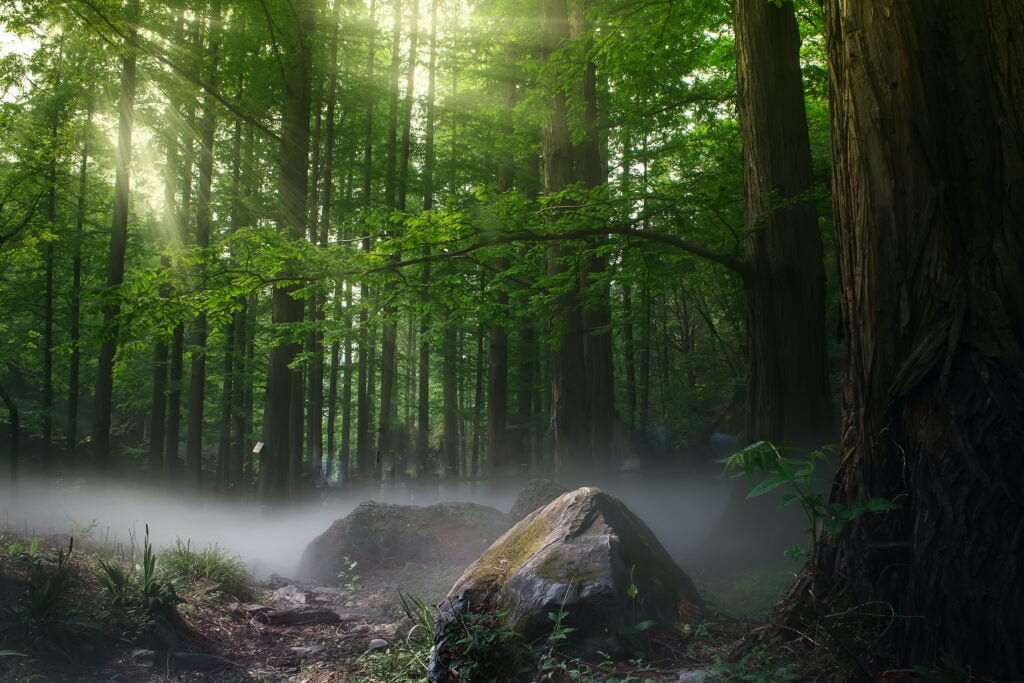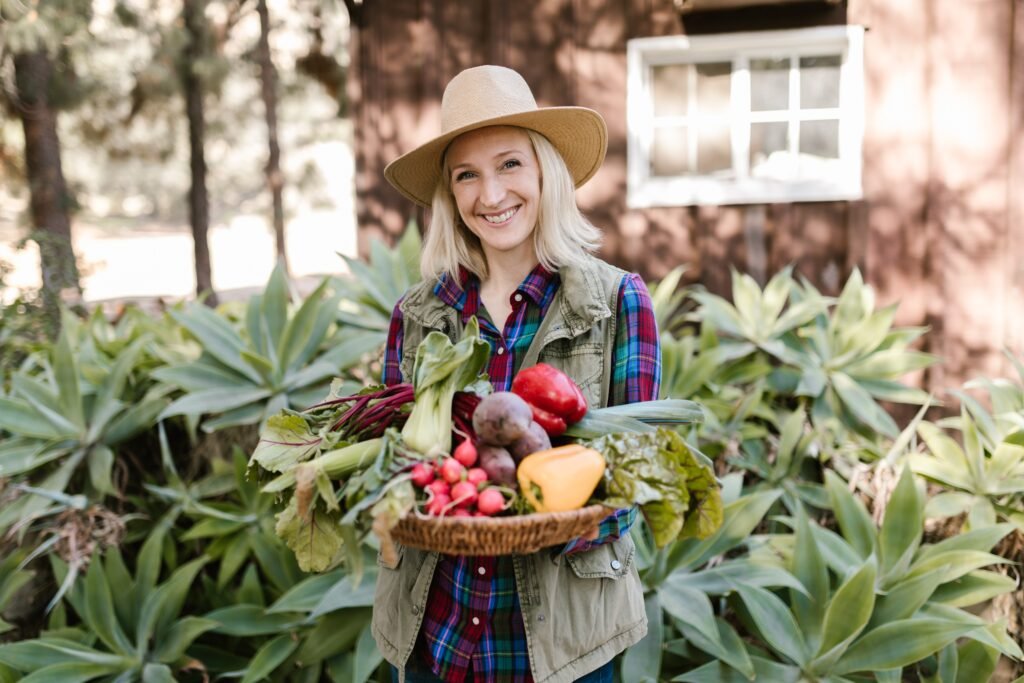Forest Bathing: Shinrin-Yoku is not just another wellness trend—it’s a serene call from nature, beckoning us to pause and reconnect.
Born in the heart of Japan, this practice goes beyond a simple walk in the woods; it’s an immersive experience where nature’s rhythms sync with our heartbeat, offering healing and tranquility.
So, let’s step away from the digital chaos for a moment and dive into the serene embrace of shinrin-yoku.
Some of the links in this post are affiliate links. This means if you click on the link and purchase the item, I will receive an affiliate commision at no extra cost to you. All opinions remain my own. Read more on our Privacy Policy page
What does shinrin-yoku mean?
Shinrin-yoku is a Japanese term where “shinrin” translates to “forest,” and “yoku” means “bath.” Together, they convey the concept of “bathing in the forest atmosphere” or “taking in the forest through all our senses.”

The Origin of Shinrin-Yoku
The story of Forest Bathing: Shinrin-Yoku is intertwined with Japan’s deep respect for nature. While the neon lights of Tokyo and the technological wonders might dominate our perception of the country, it’s essential to remember the spiritual heart of Japan beats in tandem with nature. Mountains, rivers, and forests aren’t just geographical features; they’re central characters in Japanese folklore, spirituality, and everyday life.
Shinrin-Yoku emerged in the 1980s, but it was more of a rediscovery than an invention. With urbanization advancing at an unprecedented pace, the Japanese felt the need to reconnect with their ancestral roots. City dwellers were finding themselves increasingly stressed, and the answer, it seemed, lay not in modern medicine but in an embrace of ancient wisdom.
Forest Bathing was presented as an antidote to the urban hustle. It was not about hiking or physical exercise; it was a return to stillness, a mindful immersion in the forest’s embrace. The aim was simple: absorb the forest’s sights, sounds, and scents, and let them work their therapeutic magic.
Today, Shinrin-Yoku isn’t just a solitary practice for the Japanese. It’s become a communal endeavor, with dedicated trails in Japan designated for this purpose.
So, while the term Shinrin-Yoku might be relatively new, the ethos it embodies—harmony with nature—is an age-old Japanese philosophy, reminding us of the timeless bond between humans and the verdant world around us.
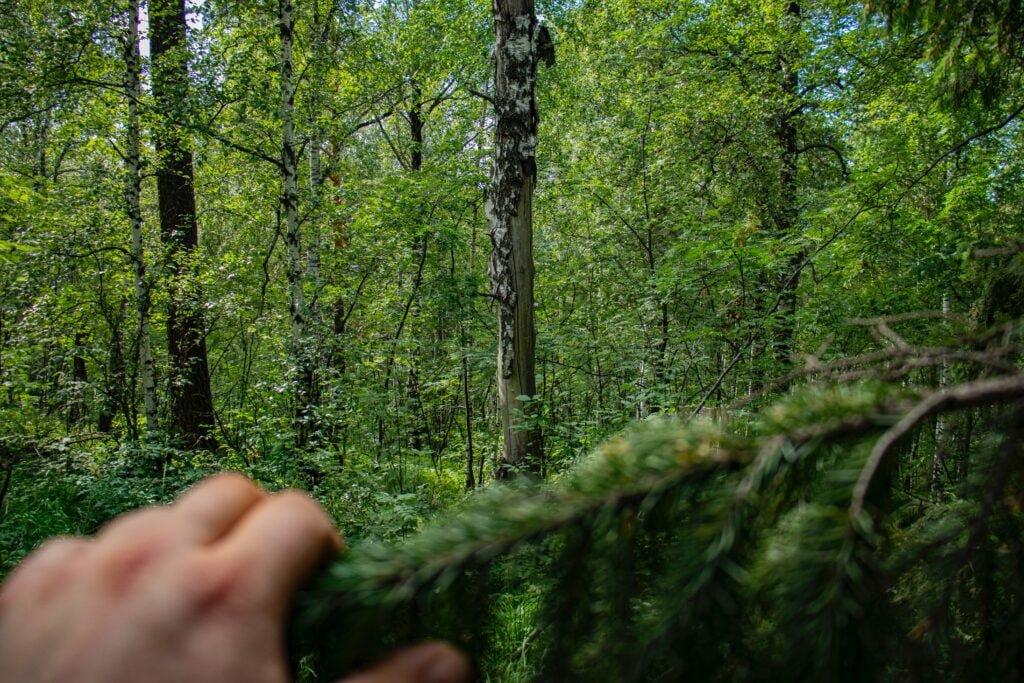
What are the benefits of forest bathing shinrin-yoku?
- Stress Reduction: Decreases cortisol levels, promoting relaxation and mental calmness.
- Immune System Boost: Enhances the activity of natural killer cells, bolstering the body’s defenses against diseases.
- Antioxidative Effects: Exposure to phytoncides, natural compounds from trees, rejuvenates the body at a cellular level.
- Neurological Enhancement: Improves focus, memory, and creativity by providing a refreshing environment for the brain.
- Emotional Wellness: Reduces anxiety levels, mood disorders, and feelings of fatigue. Promotes mindfulness and emotional grounding.
- Connection to Nature: Deepens the bond with the natural world, fostering a sense of belonging and balance.
- Improved Air Quality: Breathing cleaner, fresher air aids in overall respiratory health.
- Enhanced Mood: The serene atmosphere can elevate spirits and combat feelings of depression or melancholy.
- Mindfulness and Presence: Encourages a deeper connection to the present moment, away from digital distractions.
- Community and Bonding: Shared experiences on dedicated trails foster a sense of community and shared purpose.
The Science Behind Forest Bathing
The Healing Touch of Nature
When discussing Forest Bathing: Shinrin-Yoku, it’s not merely about the poetic or philosophical appeal. Modern science has eagerly delved into understanding the physiological and psychological benefits of this ancient practice.
Stress Hormones Take a Backseat
A significant revelation is how forest environments can remarkably reduce cortisol, the primary stress hormone. When immersed in the serenity of the woods, our bodies naturally ease into a state of relaxation, alleviating the urban life’s daily pressures.
Nature’s Boost to Our Immune System
Research has shown a consistent boost in the activity of natural killer cells, components of our immune system responsible for fending off diseases. Regular exposure to forests could, in essence, act as a natural enhancer of our body’s defense mechanisms.
The Antioxidative Magic of Forest Air
Ever wondered why the forest air feels so invigorating? Phytoncides, natural compounds produced by trees, have antioxidative properties that not only cleanse the air but also rejuvenate our body at a cellular level.
Neurological Benefits: A Brain Refresh
Walking amidst trees and listening to the rustle of leaves isn’t just a sensory delight; it’s a cognitive booster. Forest environments have shown to enhance focus, memory, and creativity, possibly due to the combined effects of cleaner air, reduced stress, and the sheer beauty of the surroundings.
Emotional Wellness and Shinrin-Yoku
The mental health implications are profound. Forest bathing sessions have shown significant drops in anxiety levels, mood disorders, and feelings of fatigue. The tranquil environment encourages mindfulness, grounding individuals in the present moment, and fostering emotional well-being.
The Future of Forest Bathing Research
As interest in Shinrin-Yoku grows globally, more scientists and researchers are keen to explore its multifaceted benefits further. This ancient practice’s union with modern science promises a brighter, healthier future for urbanites seeking nature’s embrace.
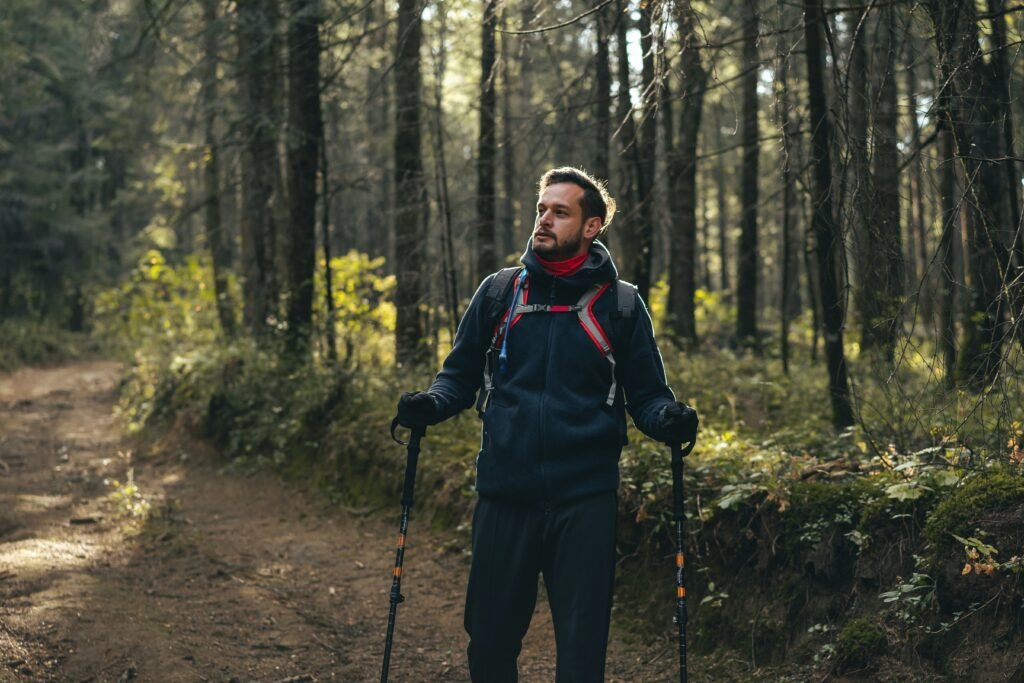
Practical Guide to Forest Bathing for Seniors
Forest Bathing for Seniors: A Step-by-Step Guide
Choosing Accessible Trails
- Opt for paths labeled ‘easy’ or ‘accessible’ to ensure a comfortable walk.
- Steer clear of trails with steep climbs or challenging terrains.
>>> Hiking equipment – check on amazon
Prioritizing Comfort with the Right Gear
- Invest in shoes offering arch support and non-slip soles.
- Consider using a walking stick or trekking poles for additional support and balance.
Staying Nourished and Hydrated
- Always carry a water bottle to maintain hydration.
- Pack light snacks, such as fruits or nuts, to keep energy levels up.
Incorporating Mindfulness Techniques
- Engage in deep breathing exercises to enhance the connection with nature.
- Soft meditation chants or guided meditations can also deepen the experience.
Exploring with Company
- Consider forest bathing with a friend or loved one for shared enjoyment.
- Joining a group can offer a sense of community and an added layer of safety.
Listening to One’s Body
- Pay attention to personal comfort and energy levels.
- It’s essential to take breaks when needed and prioritize well-being over duration.
Documenting the Experience
- Use a journal, sketches, or a camera to capture memorable moments.
- Sharing these experiences can foster connections and offer a chance to reflect on the journey.
Vintage Leather Journal Tree of Life

Embracing Nature’s Therapeutic Embrace
- Allow oneself to fully merge with nature’s rhythm and beauty.
- Recognize the rejuvenating and healing effects of forest bathing, especially during the golden years.
the Secret to Ageless Well-being: Mind-Body Practices, Anti-Aging secret
Shinrin-Yoku vs. Other Nature-Based Therapies
When discussing Forest Bathing: Shinrin-Yoku, it’s essential to understand its unique space in the realm of nature-based therapies. Let’s explore how Shinrin-Yoku stands apart and how it intertwines with other holistic approaches.
Shinrin-Yoku and Traditional Nature Walks
- While both emphasize walking in nature, Shinrin-Yoku specifically focuses on immersing one’s senses fully. It’s less about physical exercise and more about emotional and mental rejuvenation.
- Traditional nature walks might emphasize distance or physical endurance, while Shinrin-Yoku emphasizes presence and sensory connection.
The Therapeutic Landscape of Gardening
- Gardening, another popular nature-based therapy, engages individuals in cultivating and nurturing life. The hands-on interaction with soil and plants is therapeutic.
- Shinrin-Yoku, on the other hand, urges passive immersion. Participants absorb the forest’s energy without actively shaping or changing the environment.
Adventure Therapy’s Thrill vs. Shinrin-Yoku’s Calm
- Adventure therapy, which includes activities like rock climbing or white-water rafting, uses nature’s challenges to foster self-confidence and teamwork.
- Shinrin-Yoku is the antithesis, seeking nature’s calm and serenity to promote inner peace and mindfulness.
Animal-Assisted Therapies: A Different Bond
- Animal therapies, such as horseback riding or interacting with farm animals, tap into the bond between humans and animals for healing.
- While Shinrin-Yoku also focuses on connection, it emphasizes the bond between humans and the larger ecosystem, highlighting our place in the grand tapestry of life.
Ecotherapy: A Broader Brush Stroke
- Ecotherapy encompasses a wide range of activities, from gardening to nature walks, all designed to boost mental health through nature interaction.
- Shinrin-Yoku can be considered a subset of ecotherapy but stands out with its specific rituals, practices, and deep-rooted philosophy from Japanese culture.

Final Thoughts on Shinrin-Yoku’s Unique Space
Amidst the myriad of nature-based therapies, Forest Bathing: Shinrin-Yoku carves out its unique niche. It combines the age-old wisdom of Japanese culture with the universal need for nature, creating a harmonious blend of mindfulness, sensory experience, and healing. As the world looks for holistic paths to well-being, Shinrin-Yoku shines as a beacon, inviting all to embrace the forest’s gentle embrace.

Real Stories, Real Impact: Exploring the World of Forest Bathing
One of the most compelling ways to understand the profound impact of Forest Bathing: Shinrin-Yoku is through the eyes and experiences of those who have felt its magic. Let’s delve into a few testimonials and case studies that bring the practice to life.
Maria’s Awakening After Retirement
At 65, Maria felt the weight of retirement in ways she hadn’t anticipated. Days seemed longer, and the sudden abundance of free time left her feeling disoriented. On a friend’s recommendation, she decided to try forest bathing. Over weeks, she began to notice an increased sense of purpose. The forest, with its vast expanse, seemed to fill the void she felt, and she found herself more grounded, revitalized, and connected to the world around her.
David’s Recovery from Grief
Losing his wife of 40 years was devastating for David. The walls of his home seemed to close in on him, echoing the silence he felt within. One day, he stumbled upon a local Shinrin-Yoku group and decided to give it a try. The gentle embrace of nature became his refuge. As he bathed in the forest’s serenity, he began to process his grief, finding solace among the trees, feeling that nature itself was helping him heal.
Case Study: The Tokyo Forest Bathing Club
In the bustling heart of Tokyo, a club dedicated to Shinrin-Yoku has shown impressive results. Over a year, participants, primarily seniors, reported a 60% improvement in overall mood and a 40% reduction in stress-related ailments. The club, through organized trips, meditative practices, and communal activities, serves as a testament to the transformative power of forest bathing.
Linda’s Battle with Anxiety
Linda, always a city girl, had battled anxiety for years. Medications and therapy provided some relief, but the unease lingered. On a trip to Japan, she experienced Shinrin-Yoku for the first time. The effect was profound. The cacophony of city life faded, replaced by nature’s symphony. Over time, with regular forest baths, her anxiety levels dropped significantly. Linda credits the forests for giving her a fresh perspective on life and a newfound tranquility.
These stories, while unique, weave a common thread: the transformative and healing power of nature. Whether it’s battling personal demons, seeking purpose, or just finding peace, Forest Bathing: Shinrin-Yoku offers a sanctuary, reaffirming nature’s timeless role as a healer and guide.
best anti wrinkle essential oils – Unlocking the Anti-Aging Secrets
The Global Resonance of Forest Bathing: Shinrin-Yoku’s Worldwide Journey
From its humble beginnings in Japan, Forest Bathing: Shinrin-Yoku has captured hearts worldwide, becoming more than just a local practice. The global spread of Shinrin-Yoku is a testament to its universal appeal and the innate human longing to connect with nature.
The West Discovers Shinrin-Yoku
- The early 2010s saw a surge of interest in the West, especially in the US and Europe. Wellness retreats and nature enthusiasts began integrating Shinrin-Yoku principles into their programs, emphasizing the therapeutic and mindfulness aspects.
- Publications, research papers, and documentaries furthered the West’s intrigue, showcasing the tangible benefits of this ancient Japanese practice.
Establishing Official Trails and Centers
- Countries like Finland, Scotland, and Canada have designated specific trails for forest bathing. These trails are optimized for a Shinrin-Yoku experience, offering serene environments free from urban distractions.
- Dedicated centers and retreats have mushroomed across continents, offering guided experiences, training sessions, and even certifications for aspiring Shinrin-Yoku guides.
The Academic and Medical Embrace
- Universities globally have taken a keen interest in studying the effects of Shinrin-Yoku. Research projects span from understanding its impact on mental health to its potential benefits for the elderly.
- Some medical practitioners now “prescribe” nature, inspired by Shinrin-Yoku, recognizing its potency in alleviating stress, anxiety, and even certain physical ailments.
Pop Culture’s Role in Propagation
- Books, podcasts, and documentaries focusing on Shinrin-Yoku have brought the practice to mainstream audiences. Titles like “The Nature Fix” and “Forest Bathing: How Trees Can Help You Find Health and Happiness” have become best-sellers.

- Celebrities and influencers sharing their forest bathing experiences on social media platforms have further popularized the practice, making it trendy and sought-after.
Integration into Modern Urban Planning
- Urban designers and city planners, noting the benefits of Shinrin-Yoku, are now integrating green spaces, parks, and forested areas into urban layouts.
- The emphasis is on creating natural oases within cities, offering residents an opportunity to experience Shinrin-Yoku without venturing far from their homes.
A Global Phenomenon Rooted in Simplicity
Shinrin-Yoku’s global spread is not merely a passing trend. It reflects a collective awakening, a realization of nature’s profound therapeutic potential. As the modern world grapples with the challenges of urbanization, digital overload, and rising mental health issues, Forest Bathing offers a simple yet potent antidote, uniting people across cultures in their quest for peace, healing, and genuine connection.
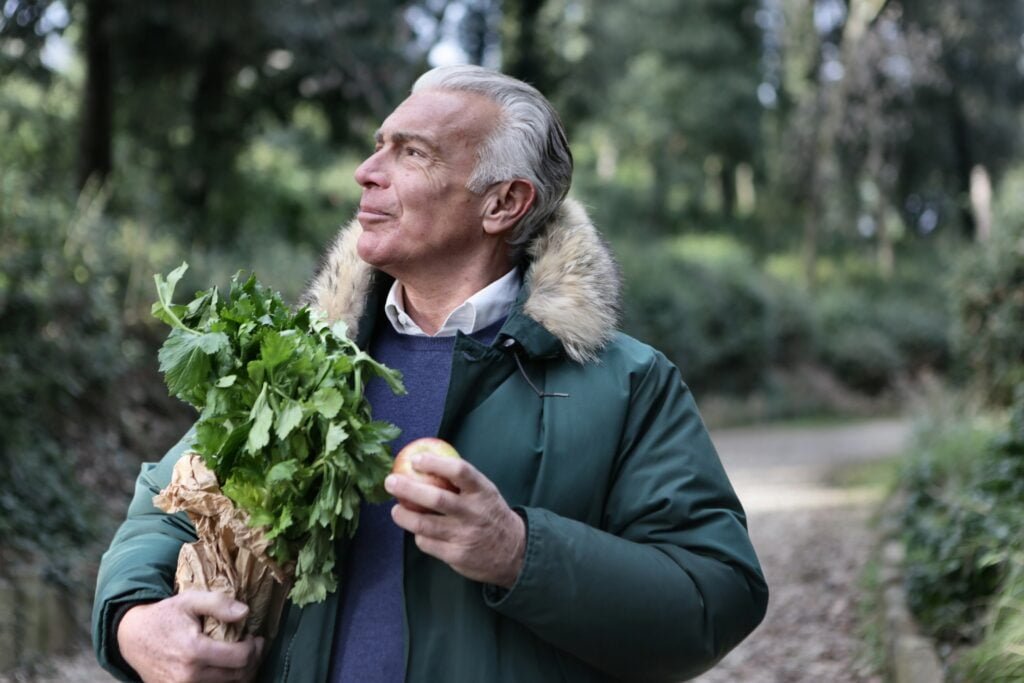
Conclusion
In the harmonious dance between man and nature, Forest Bathing: Shinrin-Yoku emerges as a soulful ballad, a gentle reminder of our intrinsic bond with the earth. From Japan’s serene woodlands to the bustling cities of the West, this ancient practice beckons individuals to pause, breathe, and find solace beneath the leafy canopy.
As our lives get increasingly digitized, and the clamor of the modern world grows louder, the silent call of the forest offers a sanctuary. The global resonance of Shinrin-Yoku is not merely about taking a walk in the woods; it’s an invitation to reconnect, rejuvenate, and rediscover the healing rhythms of nature.
So, why wait? Let the magic of Forest Bathing: Shinrin-Yoku embrace you. Venture out, let your senses roam free, and let the forest’s gentle whisper guide you towards a path of tranquility and well-being. Embrace the journey, for nature awaits!
Frequently Asked Questions: Delving into Shinrin-Yoku and Forest Bathing
What is the difference between shinrin-yoku and forest bathing?
Essentially, there isn’t a significant difference between the two. Shinrin-yoku is the Japanese term for the practice, which translates to ‘forest bath’ or ‘taking in the forest atmosphere.’ In English, we often refer to this practice as “forest bathing.”
What is the Japanese practice of forest bathing?
Forest bathing, or Shinrin-Yoku, is a Japanese practice that emphasizes a mindful and sensory immersion in a forested environment. It’s not just a simple walk in the woods. Instead, participants are encouraged to soak in the surroundings, engage all their senses, and deeply connect with nature, promoting relaxation and well-being.
references: Can forest therapy enhance health and well-being?
